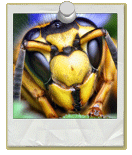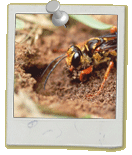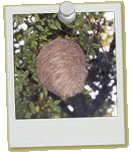BEES & WASPSHymenoptera - Apidae, Sphecidae, & Vespidae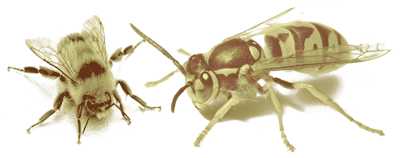
GENERAL INFO: Bee and wasp species have a dizzying array of subfamilies, with not only physical differences, but behavioral, nesting and breeding differences as well. What they all generally have in common is the fact that they sting and they fly. However, there are some bee species that do not have the ability to sting. Unfortunately no stingless species are found in Florida. Contrary to popular belief, there are bees that can sting repeatedly like a wasp - without dying shortly after - as their stingers are smooth instead of barbed. Barbed stingers get lodged in their victim and the bee eviscerates itself as it flies away. Bumblebees and carpenter bees, both found in Florida, are examples of bees that can repeatedly sting without dying. THREAT: Stinging insects can prevent someone from enjoying their living space. Bees can take over a corner, soffit or crack in the wall quite suddenly. Certain types of stinging insects are more aggressive than others. Yellow Jackets are very aggressive and determined insects. Most people do not realize that they are a wasp, not a bee, which means they can sting multiple times if their stingers' barb doesn't get lodged in its target. The main risk is an anaphylactic reaction (extreme allergic reaction) to the stings, requiring immediate medical attention. REMOVAL / PREVENTION: When a honey bee colony is located in the wall of your house, it has to be removed. The wax combs created by the bees have to be cooled by the bees. If not, they will melt and flow down through the walls. They will even seep through concrete. The stains cannot be removed and the walls will need to be replaced. This will also attract robber bees (honey bees in search of food in the winter time) and wasps as well as wax moths. This could continue to attract other insects for several years, in addition to other local pests such as rats and mice. IMAGES: Click for larger image. GENERAL CAPACITIESPhysical Strength:* Resilience:* Speed:** Aggressiveness:** Health Threat:** Property Threat: Breeding / Propagation: *Bees & wasps are very strong given their size & weight. **Brighter red indicates bee and wasp species that are particularly fast, aggressive, and a health threat via their stinging mechanism.. GEOGRAPHIC RANGE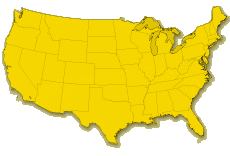
AVG. BREEDING RATELots and lots of DID YOU KNOW?Male drone bees do not have the ability to sting, as stingers are actually modified egg depositors or ovipositors. A majority of wasps are parasitic with regard to how they grow into adults. They lay their eggs in a host where their larvae grow and eat their host from within. The host dies when the larvae burst out from their host as adult wasps. |
||

